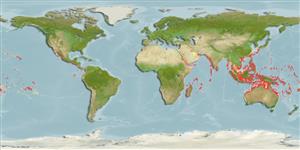Common names from other countries
Classification / Names / Names
Common names | Synonyms | Catalog of Fishes (gen., sp.) | ITIS | CoL | WoRMS
Environment: milieu / climate zone / depth range / distribution range
Ecology
Reef-associated; depth range 0 - 51 m (Ref. 101931). Tropical; 35°N - 34°S, 27°E - 10°E (Ref. 846)
Indo-Pacific. Tropical to subtropical.
Length at first maturity / Size / Weight / Age
Maturity: Lm ? range ? - ? cm
Colonies have wide range of forms from compact bushes to tables. Axial corallites are small while radial corallites are usually a mixture of sizes and are strongly appressed and swollen, with small openings.
Can be found in shallow waters (Ref. 122680). A wide range of reef environments, i.e., intertidal outer reef flat and subtidal reef edge, submerged reef tops (Ref. 86439) and rocky foreshores (Ref. 846).
Life cycle and mating behavior
Maturity | Reproduction | Spawning | Eggs | Fecundity | Larvae
Hermaphroditic (Refs. 113708, 113712). Mature gametes are shed into the coelenteron and spawned through the mouth. Life cycle: The zygote develops into a planktonic planula larva. Metamorphosis begins with early morphogenesis of tentacles, septa and pharynx before larval settlement on the aboral end (Ref. 833).
Wallace, C.C. 1999. (Ref. 86439)
IUCN Red List Status (Ref. 130435)
CITES status (Ref. 108899)
Not Evaluated
Human uses
| FishSource |
Tools
More information
Age/SizeGrowthLength-weightLength-lengthMorphologyLarvaeAbundance
Internet sources
Estimates based on models
Preferred temperature
(Ref.
115969): 24.4 - 29, mean 28 (based on 1280 cells).
Price category
Unknown.
